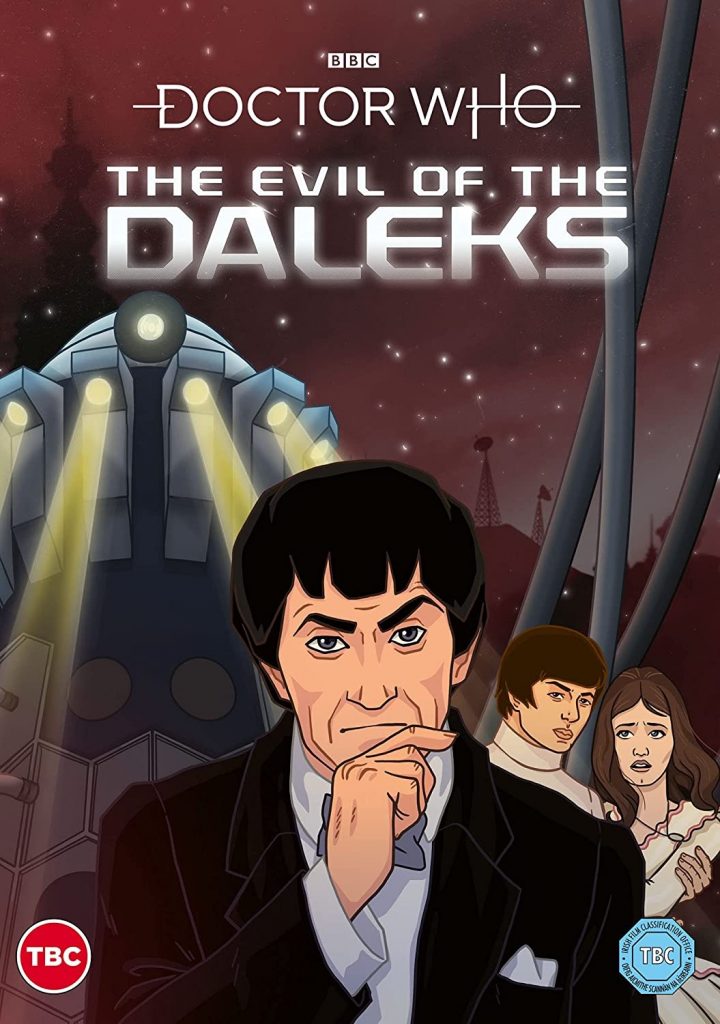
Reviewed by Tim Robins
The Story: Patrick Troughton stars in this recreation of a lost classic from 1967.
The TARDIS has been stolen. Marooned on Earth in the year 1966, the Doctor and Jamie set out to find the missing time-machine. Their investigations bring them to a mysterious London antiques shop, where all the antiques all seem to be brand new.
Kidnapped by the antique shop’s owner, the Doctor is then brought face to face with a very old enemy – the Daleks. Working from a house in Victorian England, the Daleks have a new masterplan to conquer the universe. And in order to carry it out, they need the Doctor’s help.
The original 1967 master recordings of The Evil of the Daleks were lost soon after the programme’s original transmission. However, audio-only recordings of all seven episodes have survived and have been used here to create a brand new fully animated presentation of this lost classic.
Written by David Whitaker
Directed by AnneMarie Walsh (2021 Production)
Directed by Derek Martinus (1967 Production)
Produced by Paul Hembury (2021 Production)
Produced by Innes Lloyd (1967 Production)
Starring Patrick Troughton, Frazer Hines, Marius Goring, John Bailey, Deborah Watling, Brigit Forsyth, Gary Watson, Jo Rowbottom, Windsor Davies and Sonny Caldinez.
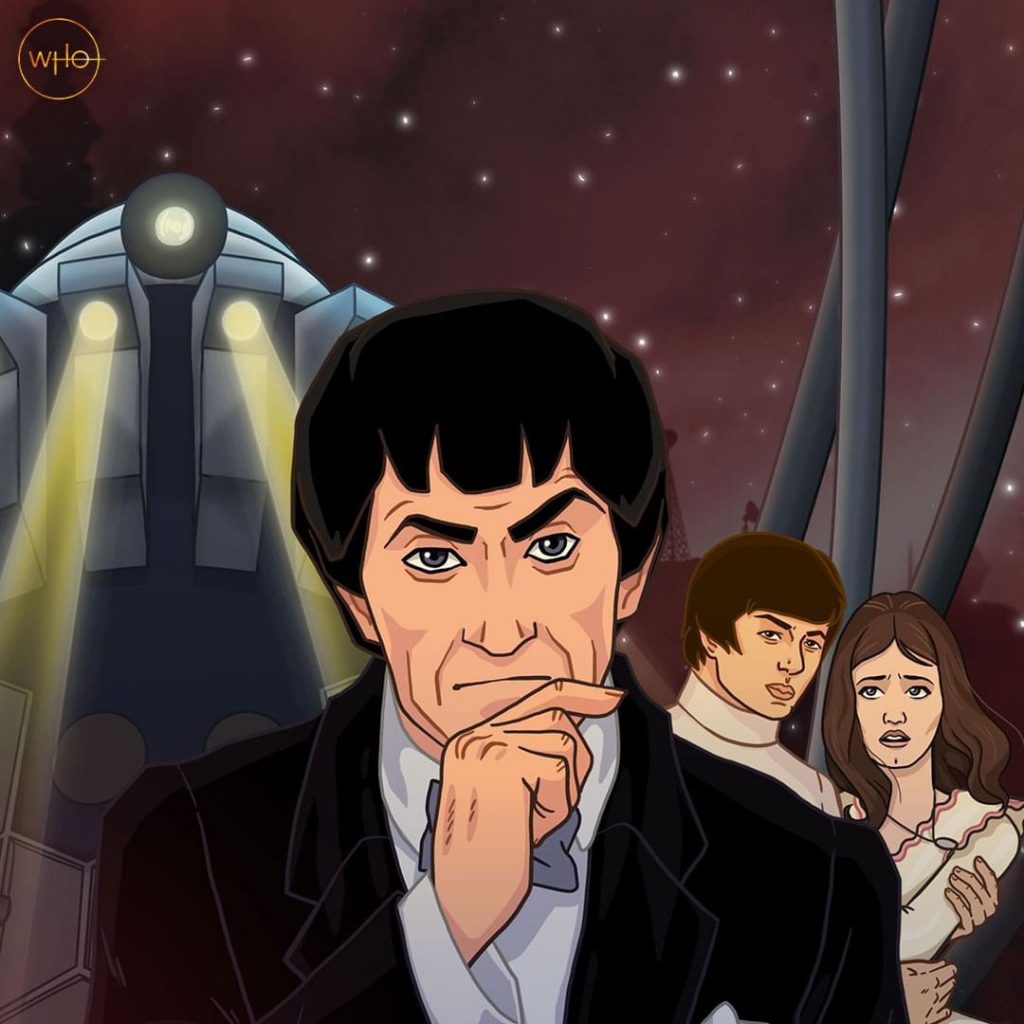
The Review: The Evil of the Daleks sees Doctor Who in full on Swinging Sixties mode, but where the preceding adventure known as The Faceless Ones borrowed something of the tone of The Avengers, The Evil of the Daleks is full on Hammer Horror, replete with frock coats and Gothic settings, including a laboratory worthy of Peter Cushing’s Baron Frankenstein.
The story clips along, partly due to David Whitaker’s script. Although the plot has plenty of what today might kindly be called “tropes”, such as people being knocked out or overhearing plot points while in hiding, it is epic in scope, moving from a trendy café and antique shop in the 1960s to the moody, dimly-lit corridors of a Victorian mansion in 1886… and, finally, to the Dalek city on the creatures’ home planet of Skaro, where a Dalek on Dalek battle brings their race to what was intended to be a devastating conclusion.

The Evil of the Daleks is one of the most memorable of Sixties’ Doctor Who adventures, made more so by being the only story to have been repeated in-continuity with The Doctor himself screening the story to impress upon new companion Zoe the terrors that lie in wait, should she decide to join him in his adventures.
I rather like the idea of The Doctor storing his adventures in a TARDIS archive, naming them after their on-screen titles and dusting them off for new companions. (“You see Rose, my fear of shrubbery began when I met the ghastly Wolf Weeds in a story I call ‘The Creature from the Pit’!”).
I am sure that The Doctor would take more care of the tapes than the BBC who scrubbed over their existing copies of the story, so that only one episode of The Evil of the Daleks remains. That episode is likely to remain the only episode, too, thanks to Dalek creator Terry Nation’s desire to wrest his creatures from the BBC and flog them to the United States. In the end, the US-based Dalek series didn’t happen – but Nation’s brazen attempt to profit from characters designed and popularised by the public service, and former Doctor Who script editor David Whitaker killing the Daleks off, a move that made way for the Cybermen to take centre stage toward the end of Patrick Troughton’s run as The Doctor.

What I remember of The Evil of The Daleks when it was first broadcast are the humorous scenes of a Dalek giving The Doctor a ride around a laboratory and others generally questioning the Black Dalek’s orders to “obey!”. These amusing but chilling moments are a result of the Doctor replacing “the Dalek Factor” (obedience, hatred and other exterminatory motivations) with “The Human Factor” (independence, friendlyness and general larking about). This experiment is done at the behest of Victorian gent Edward Waterfield, whose daughter and future companion of the Doctor, Victoria, is imprisoned in his mansion, thanks to the work of scientist-gone-mad Theodore Maxtible.
Not content with inventing a time machine, Maxtible believes that the Daleks will exchange the Doctor for the alchemical secret of transmuting iron into gold. What could possibly go wrong?
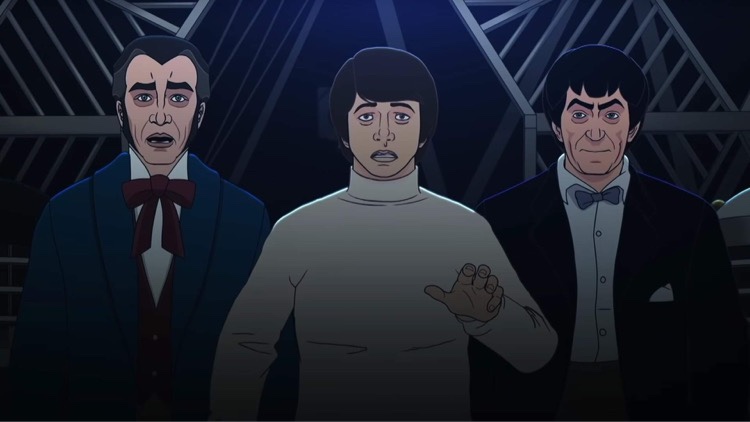
This new animated version of the story recreates the more comedic moments, although my memory parts company with a scene on Skaro featuring three rotating Daleks sqwarking “Dizzy Daleks! Dizzy Daleks!”. I feel certain that the Daleks weren’t, as in the animation, doing this of their own volition but were spun around by one of the cast. But I’m probably wrong. “Memory cheats,” The Doctor once said.
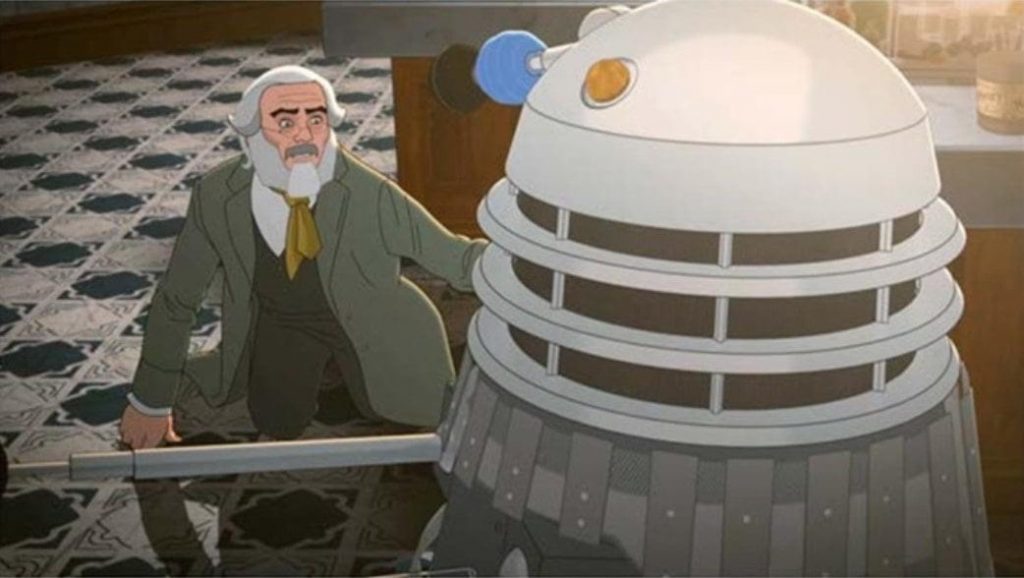
The adaptation did clear up one question that I had from hearing the audio-only version back in the day (that day being the 1980s). Waterfield draws attention to the fact that Victoria resembled her mother whose portrait hangs over a mantle piece. This turns out not to be an undeveloped plot point but a way of establishing that the girl imprisoned in a room is Victoria. This script move is a way of working around the fact that, as an isolated prisoner, Victoria can’t be introduced to the rest of the characters by, for example, her Father – and she obviously wasn’t on first name terms with her captors, the Daleks.
In any case, this is the first animated adaptation of Doctor Who’s missing episodes that I can wholeheartedly and unequivically recommend. Obviously, we are not talking about Walt Disney/Pixar but neither are we talking 1970s Scooby-Doo Where Are You?, nor the manipulated cardboard cut-outs of Captain Pugwash. Either the animation studio was given plenty of time thanks to lockdown, or the BBC has finally thrown enough money at the enterprise to produce a highly watchable and involving recreation of the show’s live action episodes.

The animation is 2D and computer modeled 3D. The latter works well on the Daleks but an ambitious establishing shot tracking from the grounds of the mansion into the living room calls unnecessary attention to itself and the grass in the grounds really demands more texture. On-broadcast, the set design made exhaustive use of the BBC’s prop store and I smiled when the animation tracked past items such as chairs, statues, vases familiar from early William Hartnell adventures.
What really works well is the extensive use of movement: the Dalek “arms” twitch, and the Emperor’s nutrient tubes sway around in an unnerving manner. This, and the human character movements, make this one of the more animated animations. I also particularly appreciated touches such as the steam from the Tricolour Cafe’s coffee machine, and the bits of straw drifting around scenes in a barn.

Offered the option, I watched the episodes in colour because, well, why not? Victorian taste in interior decoration could be a bit of an eyesore, or at least as it is recalled by film and TV drama, but when we get to Skaro colour really pays off by contrasting the scorched umbra of the planet’s surface with the steel blue interiors of the Dalek City. There are also some smashing lighting effects in the musty mansion.
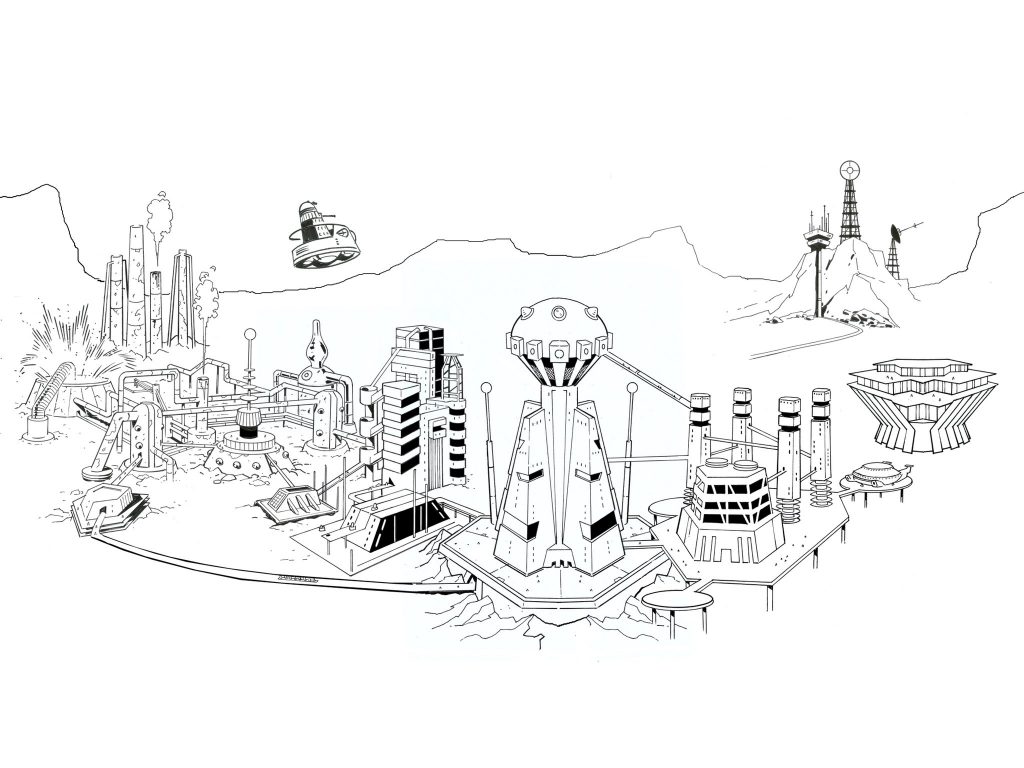
The character designs work well, particularly Marius Goring’s Maxtible, whose theatrically caricatural beard is designed to give the character now a more sinister aspect.
As I have said before, DOCTOR WHO WAS NOT MADE TO BE ANIMATED but, with The Evil of The Daleks, director AnneMarie Walsh and her team show, it can be, with great success.
I bought the BluRay for the animated adaptation but I stayed for the extras. The three disc set comes with enough additional material to shake a plunger at. This includes “The Dalek Factor”, a behind-the-scenes “making of” enlivened by members of the production crew, sparky anecdotes from Frazer Hines and behind-the-scenes footage; “The Last Dalek”, showcasing the filming of the Dalek city at Ealing; and the curiously titled “An Assignment with Grim Evil”, Phil Newman’s charming interview with designer Chris Thomson. This drops a real bombshell – Thomson was only 23 when he worked on the story, and designed the Emperor Dalek and its impressive throne room, although the designer reveals his favourite set in the story was the trendy Tricolour cafe.
As Eivor Martinus, wife of the story’s director Derek Martinus, points out, the BBC truly was attracting burgeoning talent. The Evil of the Daleks benefited from their creativity in the 1960s, just as this DVD/BluRay benefits all involved in the present.
Tim Robins
• The Evil of the Daleks is available now on DVD, BluRay and in a Steelbook limited edition
DVD and Blu Ray Bonus Material
• Remastered Surviving Original Episode 2
• Telesnap Reconstructions – 6 episodes
• Audio Commentaries
Audiobook, with recorded commentary by Tom Baker
• Making Of
• Photo Gallery
WEB LINKS
• Doctor Who Animator and Graphic Designer Rob Ritchie has posted a number of designs from The Evil of the Daleks animation here on Twitter
• 3D artist, writer and researcher Gav Rymill, who worked on The Evil of the Daleks animation 3D sets and props is also on Twitter and has posted on the project
ALSO AVAILABLE…

A freelance journalist and Doctor Who fanzine editor since 1978, Tim Robins has written on comics, films, books and TV programmes for a wide range of publications including Starburst, Interzone, Primetime and TV Guide.
His brief flirtation with comics includes ghost inking a 2000AD strip and co-writing a Doctor Who strip with Mike Collins. Since 1990 he worked at the University of Glamorgan where he was a Senior Lecturer in Cultural and Media Studies and the social sciences. Academically, he has published on the animation industry in Wales and approaches to social memory. He claims to be a card carrying member of the Politically Correct, a secret cadre bent on ruling the entire world and all human thought.
Categories: Animation, Doctor Who, downthetubes News, Features, Other Worlds, Television
 In Review: Doctor Who – Galaxy 4 – Animated Release
In Review: Doctor Who – Galaxy 4 – Animated Release  In Review: Doctor Who – Fury from the Deep
In Review: Doctor Who – Fury from the Deep  In Review: The Power of the Daleks – Special Edition
In Review: The Power of the Daleks – Special Edition  In Review: Doctor Who – The Faceless Ones
In Review: Doctor Who – The Faceless Ones